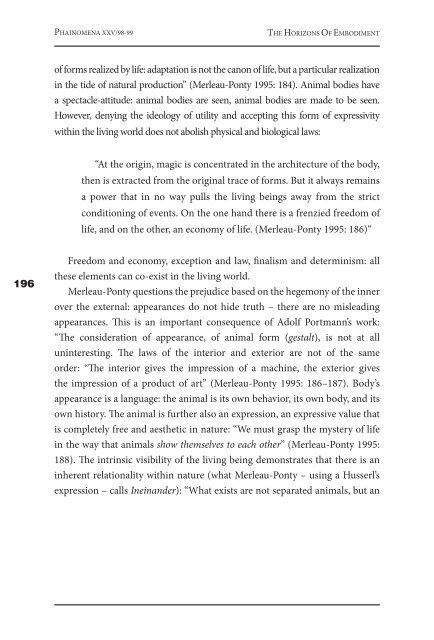phainomena
PHAINOMENA-98-99_e-verzija
PHAINOMENA-98-99_e-verzija
You also want an ePaper? Increase the reach of your titles
YUMPU automatically turns print PDFs into web optimized ePapers that Google loves.
PHAINOMENA XXV/98-99<br />
THE HORIZONS OF EMBODIMENT<br />
of forms realized by life: adaptation is not the canon of life, but a particular realization<br />
in the tide of natural production” (Merleau-Ponty 1995: 184). Animal bodies have<br />
a spectacle-attitude: animal bodies are seen, animal bodies are made to be seen.<br />
However, denying the ideology of utility and accepting this form of expressivity<br />
within the living world does not abolish physical and biological laws:<br />
“At the origin, magic is concentrated in the architecture of the body,<br />
then is extracted from the original trace of forms. But it always remains<br />
a power that in no way pulls the living beings away from the strict<br />
conditioning of events. On the one hand there is a frenzied freedom of<br />
life, and on the other, an economy of life. (Merleau-Ponty 1995: 186)“<br />
196<br />
Freedom and economy, exception and law, finalism and determinism: all<br />
these elements can co-exist in the living world.<br />
Merleau-Ponty questions the prejudice based on the hegemony of the inner<br />
over the external: appearances do not hide truth – there are no misleading<br />
appearances. This is an important consequence of Adolf Portmann’s work:<br />
“The consideration of appearance, of animal form (gestalt), is not at all<br />
uninteresting. The laws of the interior and exterior are not of the same<br />
order: “The interior gives the impression of a machine, the exterior gives<br />
the impression of a product of art” (Merleau-Ponty 1995: 186–187). Body’s<br />
appearance is a language: the animal is its own behavior, its own body, and its<br />
own history. The animal is further also an expression, an expressive value that<br />
is completely free and aesthetic in nature: “We must grasp the mystery of life<br />
in the way that animals show themselves to each other” (Merleau-Ponty 1995:<br />
188). The intrinsic visibility of the living being demonstrates that there is an<br />
inherent relationality within nature (what Merleau-Ponty – using a Husserl’s<br />
expression – calls Ineinander): “What exists are not separated animals, but an


